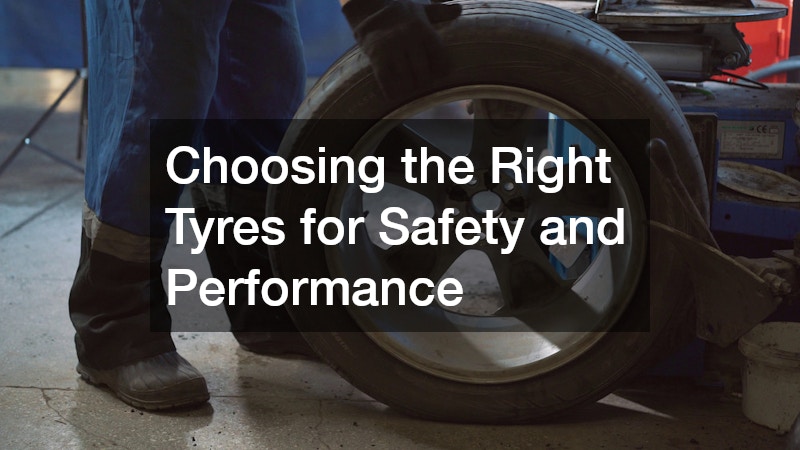Selecting the right tyres is essential for safety and vehicle performance. They are the only contact point between your car and the road, so choosing wisely affects handling, braking and fuel efficiency.
Understanding the options available and proper maintenance helps drivers make informed decisions for their driving conditions.
What Are the Different Types of Tyres Available?
All-Season Tyres
All-season tyres provide balanced performance across a variety of conditions. They handle dry, wet and light winter roads reasonably well, making them a practical choice for most everyday drivers. Their tread is designed to offer reliable grip year-round without needing seasonal swaps.
Summer Tyres
Summer tyres are built for optimal handling on warm and wet roads. They enhance braking and cornering performance, but are unsuitable for cold or icy conditions. Swapping them out in winter is necessary to maintain safety.
Winter Tyres
Winter tyres stay flexible in low temperatures, improving grip on frost, ice and snow. Even in parts of Australia with milder winters, these tyres can improve control and reduce accident risk in slippery conditions.
Performance Tyres
Performance tyres maximise handling, cornering and speed. Common on sports and high-performance vehicles, they provide superior grip but may wear faster and offer less comfort than standard options. Choosing them depends on driving style and needs.
How Do Tyre Features Affect Safety and Performance?
Tread Patterns
Tread patterns affect traction and handling. Deep grooves and specialised designs channel water away, reducing the risk of hydroplaning and improving grip in wet conditions. Knowing how patterns perform helps drivers select tyres suitable for their usual roads.
Tyre Materials
The materials used in tyres influence durability, traction and overall performance. High-quality compounds resist wear and maintain grip longer, while cheaper materials may degrade quickly. Choosing well-made tyres ensures consistent performance and safety.
Tyre Pressure
Maintaining correct pressure is essential for safe driving. Underinflated tyres reduce handling and increase fuel consumption, while overinflation decreases grip. Checking and adjusting pressure regularly keeps performance at its best.
Tyre Size
Choosing the correct tyre size is vital for safety and efficiency. Incorrect sizes can affect handling, braking and fuel use. Always follow manufacturer recommendations to ensure the vehicle operates as intended.
How to Maintain Your Tyres for Optimal Performance
Regular Inspection
Regular inspections identify wear, damage or foreign objects before they become serious problems. Monitoring tyre condition helps maintain grip, braking efficiency and overall safety.
Alignments and Rotations
Wheel alignments and tyre rotations prevent uneven wear and maintain handling. Rotating tyres according to schedule extends lifespan and keeps performance consistent.
Proper Inflation
Keeping tyres inflated to recommended levels improves fuel efficiency, handling and braking. Simple monthly checks can prevent issues and prolong tyre life.
When to Replace Tyres?
Tyres should be replaced when tread is worn, damaged or aged. Worn tyres reduce grip and braking performance, increasing the risk of accidents. Timely replacement protects both the vehicle and its passengers.
How to Choose the Right Tyres for Your Vehicle
Considering Vehicle Type and Usage
Vehicle type and driving habits influence the ideal tyre choice. SUVs, sedans and sports cars have different requirements, so matching tyre features with usage ensures safety and efficiency.
Consulting Manufacturer Recommendations
Manufacturers provide guidelines for tyre type, size and pressure. Following these ensures optimal performance, maintains warranty coverage and protects your vehicle.
Budget vs. Quality Considerations
While cost is a factor, prioritising quality improves safety and longevity. Investing in reliable tyres reduces wear and can save money on fuel and maintenance in the long run.
Environmental Factors
Road surfaces, climate and seasonal changes affect tyre performance. Choosing tyres suited to local conditions helps maintain grip and handling, improving overall driving safety.
Selecting the right tyres is key to maximising safety and overall vehicle performance. Different options offer varying levels of grip, durability and handling characteristics, so understanding the types available and the features that affect performance is essential. Regular maintenance, such as monitoring tread depth, pressure and wheel alignment, also plays a crucial role in ensuring optimal function. By carefully matching your choice to your vehicle, driving style and the conditions you most often encounter, you can improve braking response, cornering stability and fuel efficiency. Making informed decisions not only enhances day-to-day driving safety but also extends lifespan, helping you get the most value from your investment while keeping every journey reliable and secure.

